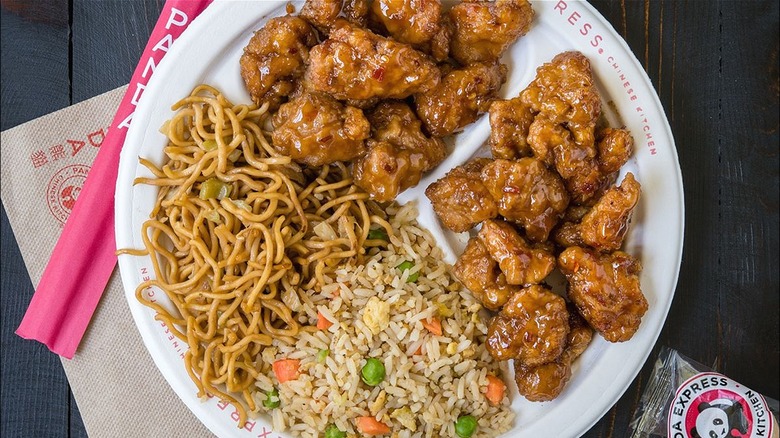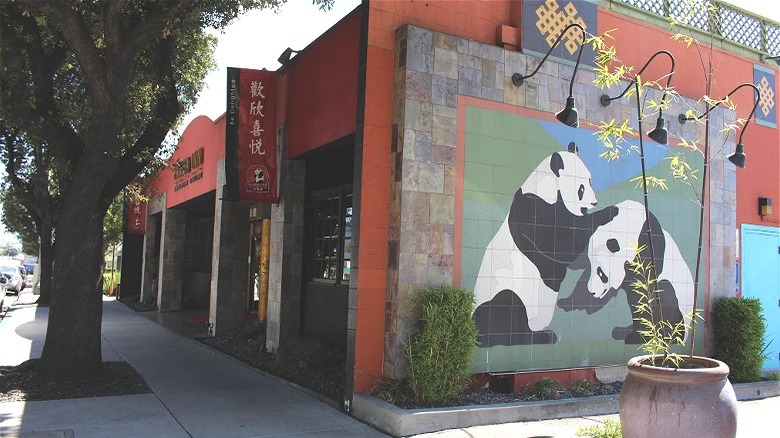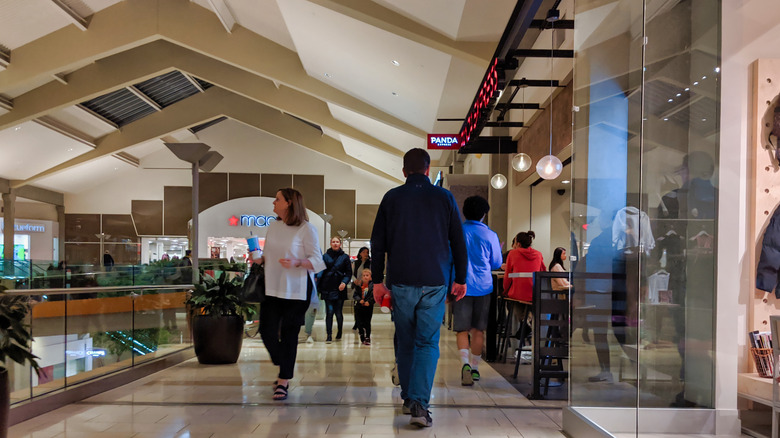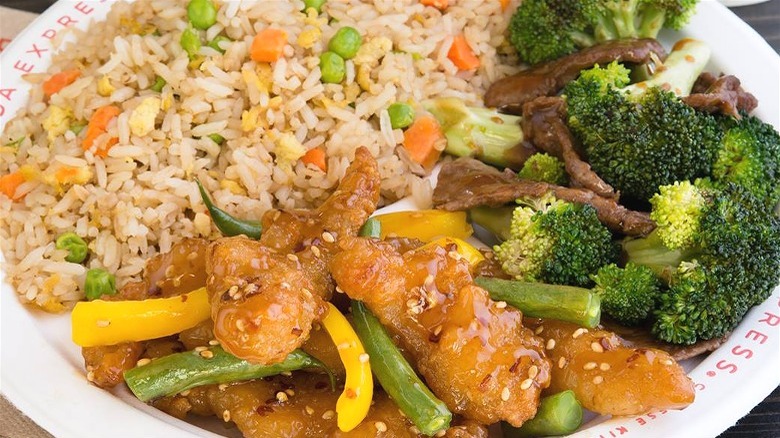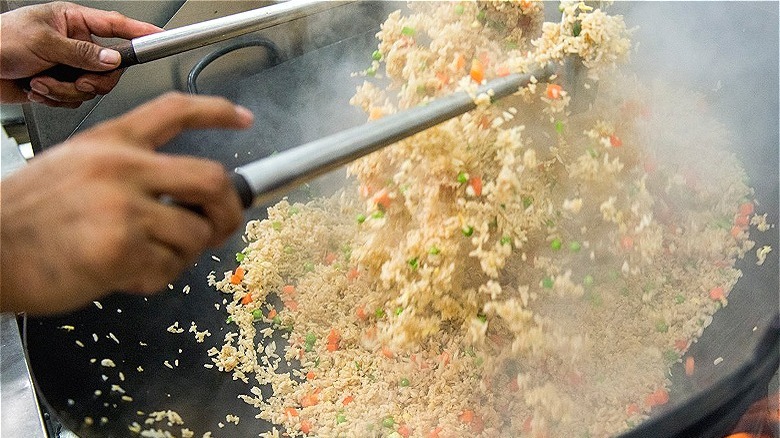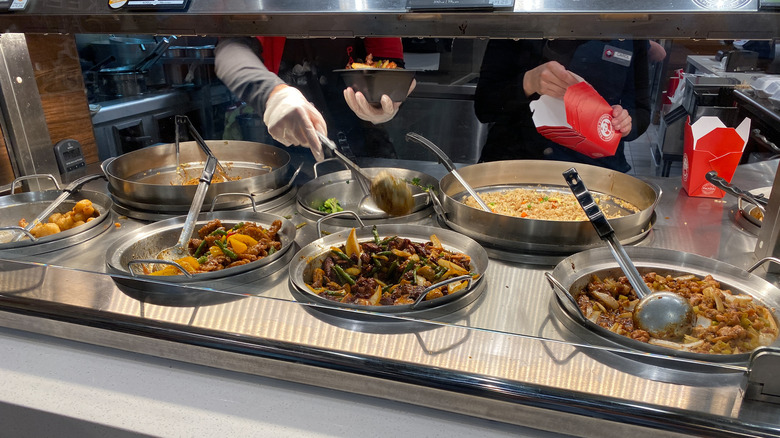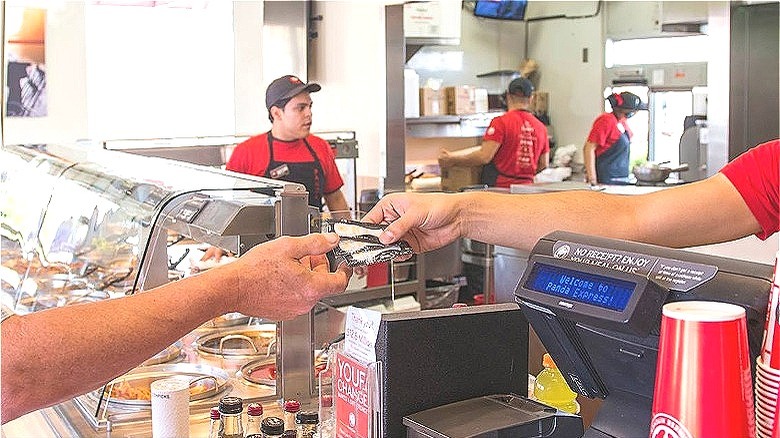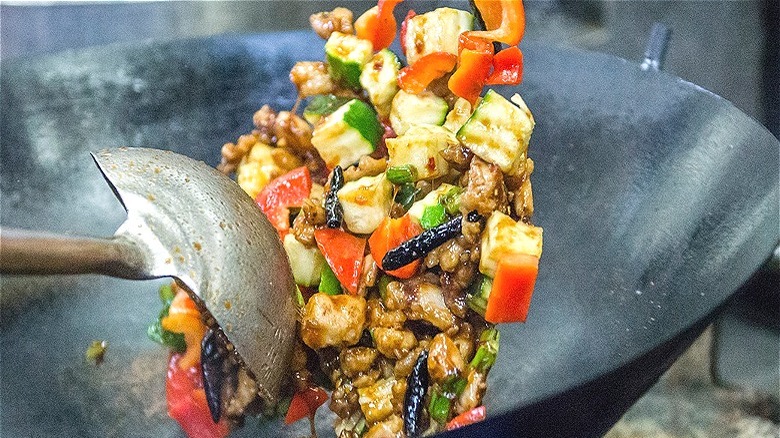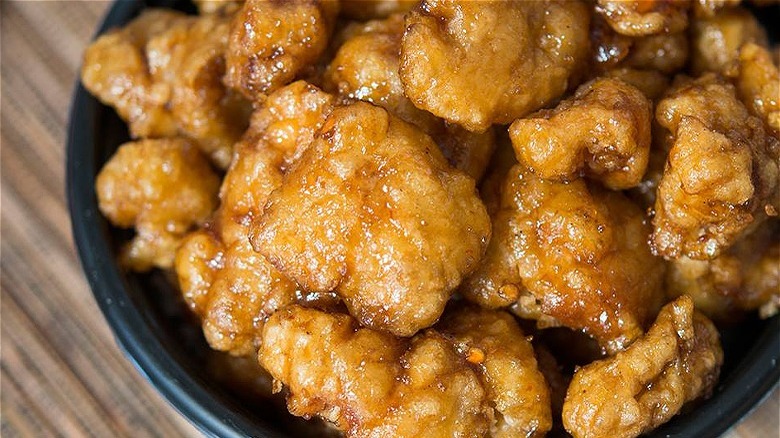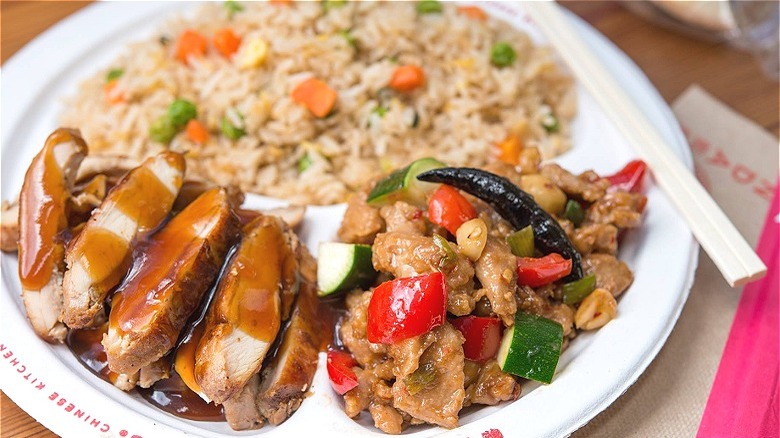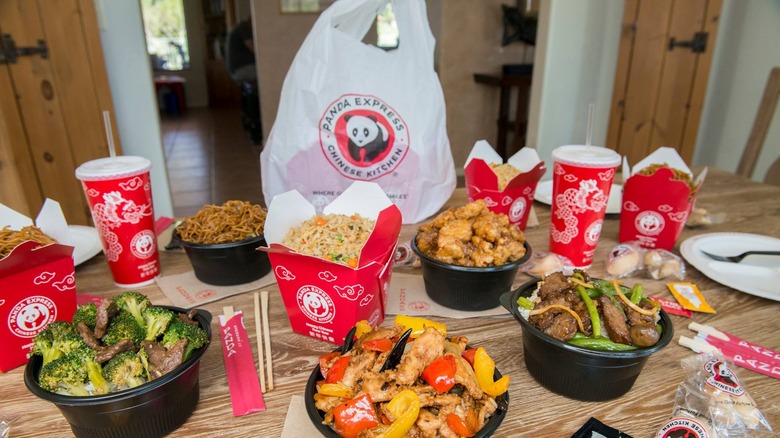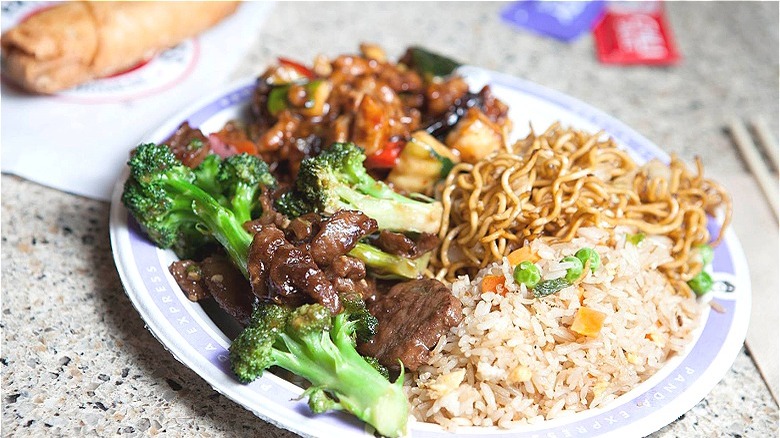What It Was Like To Eat At The First Panda Express
Panda Express has been offering quick-service Chinese food indulgence since 1983. The chain and food court staple has really set the stage for Chinese cuisine done the American way. Customer favorites like Orange Chicken and Honey Walnut Shrimp have catapulted the company into a billion-dollar empire, with over 2,000 locations around the globe catering to the insatiable appetite for all things Panda. Today, founders Andrew and Peggy Cherng operate the iconic company under the Panda Restaurant Group umbrella, which includes businesses Hibachi-San and Panda Inn. The Cherngs have enjoyed massive success as leaders and philanthropists.
However, at one point, Panda Express was not the global phenomenon sporting accolades from Fortune and Forbes. When the couple immigrated to Southern California in the 1970s, they began working on building restaurants that showcased authentic, homemade Asian foods. Later, one venture, in particular, would evolve out of the brick-and-mortar retail boom and, as a result, help define the mall food court's place in the U.S. culinary landscape. The first Panda Express definitely evokes nostalgia (and a massive craving for spring rolls), but there's a lot more to the story than glossy retail hubs and bountiful entrée plates. Have you ever wondered what it's like to eat at the first Panda Express?
Panda Express emerged out of an earlier restaurant
The first Panda Express was established in Glendale, California, but in some respects, the concept came about in Pasadena. That's because a decade prior to the chain's debut, Andrew Cherng was busy working at his first business, Panda Inn. The Chinese eatery was a far cry from the fast food Panda Express would become known for and sparkled with upscale flair, offering traditional entrées in a refined sit-down environment. It was a true family-operated business: Cherng's father, Ming-Tsai, oversaw the cooking while the rest of the family, including Andrew, waited tables and bonded with the customers who came in. Due to tight finances, all of them worked without any pay.
What was the food like? Cherng spoke with KCET in 2013 and recalled that some of the specialties available to locals at the time were more in line with typical Asian specialties in the region. One of Panda Inn's prime dishes was Moo Shu Pork, a stir-fried pork entree with egg and vegetables in a gingery soy sauce that's not dissimilar from the Black Pepper Chicken or Beijing Beef sizzling in woks today. Panda Inn, with its elevated cuisine and classy ambiance, is very different from its fast-casual cousin.
You would have had to go to the mall to eat at the original Panda Express
The 1980s was a rad time for fashion and music. For many people, the "it" activity at the time was, of course, shopping at the mall. Despite food courts accounting for a small portion of the chain's footprint, today, Panda Express' legacy is undoubtedly tied to these big-box retail destinations because, well, that's where it got started. The first Panda Express opened at the Glendale Galleria Mall, a retail haven of consumerist glory in Los Angeles County. If you picture shoppers lining up at the counter to order lunch, you'll realize it's a scene that hasn't changed all that much since Panda Express first opened in October 1983.
Now, it isn't hard to understand why the Cherngs decided on the mall as their first stop following Panda Inn. As fast food became regularly situated in American life, it was clear customers sought out quick, easy options that were just as tasty as anything served in a sit-down restaurant. In fact, the eatery's name signifies this: An "express" restaurant implies quick takeout service over table service. In other words, Panda Express is perfect for gobbling down after a try-on session at Macy's.
A star football coach helped launch the first location
Los Angeles is a buzzy town, and it's not uncommon for business owners to mingle with some of the city's well-connected residents. For the Panda Express founders, this was the Donahue family. While steering the UCLA Bruins to victory may be Terry Donahue's lasting legacy, the star coach played an important role in popularizing Panda Express. One of the more fascinating footnotes in the chain's lore is how the sports icon planted the idea for a casual Chinese joint at the Glendale Galleria.
The story goes that Donahue frequently went to Panda Inn, where he got to know the couple firsthand and extended an invitation to launch a new restaurant at the aforementioned shopping complex. The Donahue family owned the Glendale Galleria, so Terry mentioned that free space has opened up in the food court. Andrew Cherng smartly took advantage of this coincidence and decided to shoot his shot with a Panda Express kiosk. Forty years and thousands of stores later, that move has definitely paid off.
The food was different from typical Chinese fare offered at the time
The food Panda Express makes is generally viewed as American-style Chinese, but upon closer examination, it blends the fiery, peppery notes of Mandarin and Szechuan flavors. Suffice it to say, this fusion wasn't the norm in the early 1980s. Most of the dishes served in the Southern California region at the time fit into the Cantonese tradition. Cantonese food, which gained popularity with diners in the United States out of South China, pretty much defines the typical takeout fare enjoyed by the masses then and now: Mild amalgamations of steamed rice, grilled vegetables, and meats like chicken and pork are just a couple of the cuisine's defining features.
Part of the issue with Cantonese cuisine being so popular is that it was massively oversaturated. Andrew Cherng encountered this problem early on during the Panda Inn era, and the solution he ultimately took to distinguish his eatery from the rest would set the tone for his future chain. He shook up the ingredients and spices, as well as leaned on specialties diners wouldn't eat elsewhere.
The first Panda Express was busy from the get-go
It didn't take long for that first Panda Express to carve out a name for itself and create a loyal customer base of hungry shoppers looking for a bite to eat while shopping. While Andrew Cherng would actually approach people who left Panda Inn because there were no free tables, and the convenience offered by Panda Express made it an immediate sensation: From the moment it opened for business at the food court, the takeout spot was busy, busy, busy. There's no doubt you'd endure somewhat of a wait to grab your entrées, especially if you braved the lunch and dinner rushes that we still contend with.
Part of the reason some people detest malls is, of course, the busyness: Weaving through huge hordes of strangers can make you feel like a canned sardine fast. And yet, the jam-packed environment that feels so disorienting is exactly what helped Panda Express grow into the enterprise it is today. In fact, in an interview with the chain's in-house podcast Panda Expressed, Andrew Cherng praised the mall format for essentially cultivating the foot traffic the business needed to thrive. Because malls attract people for a host of activities, trying on clothes, say, or purchasing gadgets, potential diners don't need to be flagged down in order to check out a new restaurant.
A small team worked at the first restaurant
Panda Express is a mega-chain these days, and the humungous workforce (almost 40,000 at the time of writing) doesn't let you forget it. However, that number barely cracked a dozen employees when it was first getting started. It's easy to forget that Panda Express was once a mom-and-pop establishment, and nothing illustrates that point more than the skeleton crew churning out egg rolls and noodles by the platter. Only 10 people were connected to the company back then, and those were the same people who cooked, cleaned, and handled the non-stop flow of shoppers whose hunger pulled them in with a gravitational force.
Most chains have double the employees that Panda Express had in 1983, around 17 per store, give or take, so this should give you an idea of the difficulty the brand-new business endured. But finding its footing didn't take long. Despite the sort of pressure-cooker climate that could make some restauranteurs throw in the towel, starting off with such a small team wasn't the disaster you'd assume it to be. In fact, Andrew Cherng takes a lot of pride in how the fledgling company was able to ride through the chaos, and he recalled the "exciting" atmosphere of the restaurant on its first day of business.
Employees would take your order on a computer
In this day and age, fast food workers punch your order into a computer system. It's fast and requires no manual work to communicate the details to the back-of-house. This system, referred to as Point-Of-Sales (POS), also mirrors how Panda Express operated in the early 1980s. More accurately, though, the Glendale restaurant would have probably been one of the few eateries featuring such technology.
Peggy Cherng is often viewed as one-half of the Panda Express leadership team, but really, it was her engineering experience that grew the mall staple into an indestructible empire. With an educational background in math and computer science, she used her talents to whip up a software tool for the restaurant. Not only did the digital system allow for order-taking via a screen, but it also stepped up automated functions for normally time-intensive tasks like supply tracing and data analysis. Like any pioneering advancement, there were hurdles in getting the hang of it, as Cherng told the Los Angeles Times in 2015. But once the wrinkles had been ironed out, dishing out meal after meal became incredibly smooth.
The menu contained tweaked versions of Panda Inn's dishes
Since Panda Inn was the original blueprint of Panda Express, you might be wondering which elements of the original model were tweaked to fit the express model. In the food department, many of the Panda Inn entrées were dressed down to make for quicker preparation in the kitchen. By extension, early customers would have also savored exclusive creations to boot. Andrew Cherng's, Ming-Tsai Cherng, commanded the kitchen at Panda Inn. The dishes he created formed the foundation of Panda Express' full menu.
Contrary to the perception of switching from one restaurant to another, tweaking the dishes wasn't exactly a walk in the park. To fit the casual vibes of a food court, the entrées needed to be hot, fresh, and ready for customers to dig into immediately. Kazan Today confirms that many of the changes were implemented after the restaurant had already opened up to the public. The Cherngs had to adapt as they assessed whether certain items could thrive on a steam table indefinitely or end up wilting down to sad, soggy proportions. Presumably, past mushy failures likely lead to the chain's strict practice of making frequent batches of food.
Orange Chicken was nowhere on the menu
If Orange Chicken is your go-to Panda Express order, then join the club. It's sticky, tangy, and crunchy in all the right places: Fans rightly salivate over this glazed delicacy that's undoubtedly the crown jewel of the menu. No other dish compares in terms of the pure volume hawked annually, and yet, first-time patrons at the Glendale Galleria wouldn't have had a clue about it. Panda Express predates the coveted menu item by about four years: That's right; four long years (practically half a decade) passed before the iconic entree made it to the lineup in 1987.
Today, Orange Chicken is Panda Express's signature item, but when it was initially conceived by the chain's in-house chef Andy Kao, it was little more than a local specialty. For those fuzzy on the details, the entree originally came out of Hawaii, where according to NPR, a few restaurants served it prior to becoming a national offering. Better yet, locals who were dining on it before the rest of the country weren't eating the version we've grown familiar with now: Early renditions in the Aloha State featured bone-in poultry as opposed to the juicy, all-meat nuggets coated in breading we see today.
You can find many of the same entrées today
It's normal to see Panda Express menu items come and go as the company inevitably transforms into a billion-dollar brand. And with a few exceptions (such as the Orange Chicken), the items you'd see at the food court in the restaurant's early days aren't far off of the chain's offerings 40 years later. Whether it's stir-fried pork or mountains of chow mein, the same delicious options have been in rotation for as long as the company's been inside a food court.
Kung Pao Chicken is an example of an entrée that past and present customers have partaken in for years. It's a staple for a good reason too. The dish embodies the Szechwan sensibilities of heat and spice, so the tongue-tingling bite has always been there. Perhaps the only difference is that today, the dish carries a "Wok Smart" label that marks the dish as a nutritionally sound option, but besides that, the recipe of peanuts and chicken tossed with chopped peppers and zucchini (an exclusive touch, according to Cherng) is quite similar to the batches made by the chain today.
Panda Express may have been your first taste of chain Chinese food
Nowadays, Panda Express isn't the only chain on the block slinging spring rolls for the masses. Today, Chinese chain restaurants like Pei Wei and P.F. Chang's, among several others, specialize in Asian food and offer wonderfully convenient accessibility. The Glendale-based restaurant was definitely not the first Chinese restaurant by any means, but at the time, it very well could have been your first taste of Chinese chain food in the modern sense. Quite simply, the brand was the first to pull it off in the United States and find major success.
The fast food sphere has really evolved since the 1980s, and that can be evidenced by considering the makeup of the food court before Panda moved in. Most malls would have been dominated by quick-bite foods like pretzels, hot dogs, and pizza by the slice, along with a few relatively rare Greek establishments. While most of the foods offered at the food courts in the 1980s would have made for satisfying snacks. Panda Express was one of the few chains offering full plates of food that included rice, veggies, and noodles to food court customers at the time.
You can still eat at the first Panda Express
The Glendale Galleria has endured as one of Southern California's top shopping destinations, and so, by proxy, has the first Panda Express. Visit the first floor, and you'll see the original serving counter. As a bonus, you can also browse other first-time locations, such as the Disney store. In many ways, you'll be able to chow down like it's 1983 (though a lot of the stores are probably different), and that's because, for the most part, the restaurant's appearance remains markedly similar.
Andrew Cherng has remarked on the format before, noting that the steam tables, the build-your-own menu, and the dishes themselves are essentially the same that were experienced by Panda Express visitors in its early days, and this is echoed by customers alike. One Reddit user even claimed that the eatery appears the same as it was 35 years ago. So whether you're a longtime resident or happen to be in that part of town, there's hope yet of living out your ultimate mall fantasies that end, of course, with Panda Express.
